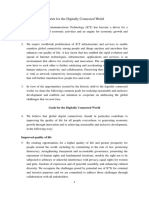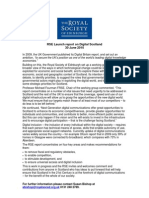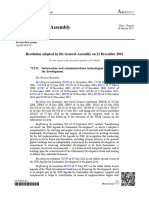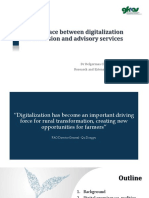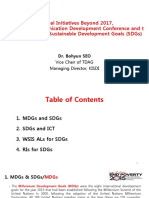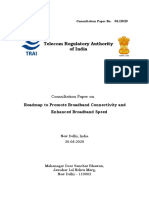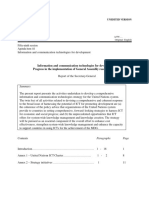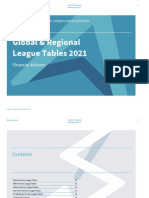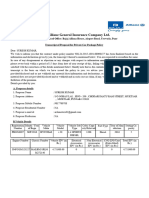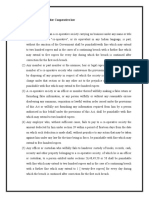MUN RESOLUTION
Resolution on Addressing the Digital Divide: Bridging Internet Access Gaps Between Urban and
Rural Areas to Promote Equal Opportunities in Education and Business
The General Assembly,
Acknowledging the critical role of the internet in shaping global economies, societies, and access to
essential services such as education, healthcare, business, and government services,
Recognizing that the digital divide remains one of the most pressing issues of our time, with a
significant gap in internet access between urban and rural areas, where urban regions typically enjoy
superior connectivity, leaving rural areas underserved and disconnected,
Concerned that the lack of reliable and affordable internet access in rural areas directly limits
educational opportunities for students, restricts access to online healthcare services and
governmental resources, stifles business innovation, and exacerbates the social and economic
disparities between rural and urban populations,
Reaffirming the commitment to Sustainable Development Goal (SDG) 9, which calls for the
development of resilient infrastructure, the promotion of inclusive and sustainable industrialization,
and fostering innovation by providing affordable access to Information and Communication
Technologies (ICT) for all,
Recalling the Universal Declaration of Human Rights, which asserts that everyone has the right to
education, the right to freely participate in cultural life, and the right to seek, receive, and impart
information and ideas through any media and regardless of frontiers,
Emphasizing that equal access to the internet is essential for achieving the full potential of the global
economy, fostering innovation, and ensuring equal opportunities for all,
Stressing the importance of collaboration among governments, international organizations, the
private sector, and civil society to address infrastructure gaps, build sustainable networks, and ensure
universal internet access for marginalized populations,
Highlighting that a concerted effort is required to ensure equitable access to digital services, allowing
rural communities to participate in global digital advancements and reduce the barriers posed by the
digital divide,
The General Assembly,
1. Calls upon all Member States to prioritize the expansion and development of high-speed
internet infrastructure in rural and underserved areas, by allocating necessary resources
towards the creation of broadband networks, ensuring that rural populations are not
excluded from the benefits of technological progress. It is essential that Member States:
o Repair and upgrade outdated infrastructure, including old telephone lines and power
boxes that often impede high-speed internet access,
o Invest in the maintenance of network towers, especially in remote areas where
infrastructure can be prone to damage and deterioration,
o Develop infrastructure that meets the increasing demand for reliable internet,
ensuring that all regions have access to modern, high-speed, and sustainable
internet services.
Failure to address these critical infrastructure issues not only violates SDG 7
(Affordable and Clean Energy) but also undermines the achievement of SDG 9
(Industry, Innovation, and Infrastructure), as it perpetuates inequality in access to
essential resources.
�2. Encourages the establishment of long-term public-private partnerships to address
infrastructure gaps, facilitate the construction and maintenance of internet connectivity, and
ensure the affordability of these services. Governments, alongside the private sector, can
work together to reduce the initial investment costs, share the financial risks, and maximize
the benefits for rural communities. Through these partnerships, internet service providers
can:
o Deliver affordable and scalable solutions for rural areas,
o Provide sustainable services with reduced costs for both users and service providers,
o Share responsibility for maintenance and development to ensure that connectivity is
not just established but maintained effectively over time.
3. Urges international organizations such as the United Nations Development Programme
(UNDP) and the International Telecommunication Union (ITU) to expand their support for
rural connectivity projects, particularly in developing countries. These organizations should:
o Offer technical guidance to governments in designing and implementing effective
internet connectivity strategies for rural regions,
o Provide financial support for countries that face budget constraints, helping to
subsidize the costs of building and maintaining broadband networks in underserved
areas,
o Facilitate the exchange of knowledge and best practices between countries that have
successfully expanded internet access in rural areas.
4. Supports initiatives aimed at reducing the cost of internet access for rural communities by
offering subsidies, tax incentives, or other financial assistance for both internet services and
necessary equipment. As affordability remains a major barrier for many rural residents, this
initiative seeks to:
o Ensure that internet services are accessible to all, regardless of income level,
o Allow students to access online educational resources, entrepreneurs to expand
their businesses, and rural populations to benefit from healthcare, government
services, and global information,
o Facilitate the establishment of local programs that subsidize the costs of devices such
as computers, smartphones, and routers to increase internet access in low-income
areas.
5. Proposes the development of mobile and satellite-based internet solutions to overcome
geographical and logistical challenges in rural areas where traditional broadband
infrastructure is difficult to implement. This would include:
o The expansion of mobile networks in underserved rural areas, ensuring that mobile
internet services are widely available,
o The use of satellite internet as a complementary solution for remote regions where
laying cables or constructing traditional infrastructure is impractical. Such
technologies have the potential to rapidly increase internet penetration in hard-to-
reach areas.
� 6. Encourages Member States to integrate Information and Communication Technology (ICT)
education into school curricula, particularly in rural areas, as a means to:
o Enhance digital literacy from a young age, preparing students for future employment
and entrepreneurship in a digital world,
o Equip students with the skills to use the internet for educational purposes,
participate in global digital economies, and safeguard against online threats such as
cyberattacks,
o Foster an understanding of the importance of internet security and empower future
generations to build secure, robust, and accessible digital environments.
7. Recommends the establishment of community centers in rural areas that offer free or low-
cost internet access, computer facilities, and online training programs for students,
professionals, and entrepreneurs. These centers could serve as hubs for:
o Providing the infrastructure necessary for education, job training, and business
development,
o Offering technical support and workshops on internet use, coding, digital
entrepreneurship, and online security,
o Promoting a more inclusive digital society by ensuring that no one is left behind due
to lack of access to technology.
8. Promotes the sharing of successful models and best practices among countries that have
effectively reduced the digital divide. Member States are encouraged to:
o Collaborate on identifying cost-effective, scalable models for rural internet access,
o Develop regional networks that share knowledge and resources to accelerate the
provision of internet connectivity to underserved areas,
o Create a platform for the exchange of experiences in overcoming common barriers
such as financial constraints, geographical challenges, and limited infrastructure.
9. Calls for the inclusion of rural digital connectivity as a core element of national development
plans, ensuring that digital infrastructure is integrated into broader economic, social, and
political development strategies. This would:
o Secure political commitment to rural connectivity, ensuring that rural populations
benefit equally from technological advancements,
o Allocate specific funding in national budgets for rural internet expansion and
maintenance,
o Encourage Member States to include rural connectivity in their long-term strategic
plans for economic development, ensuring that technology remains a tool for
inclusivity and sustainable development.
Final Clause: The General Assembly expresses its unwavering commitment to ensuring that all
individuals, regardless of geographic location, have access to the internet and the opportunities it
provides. By bridging the digital divide, Member States will contribute to the achievement of
�inclusive, equitable, and sustainable global development, fostering a future where no one is left
behind in the digital age.

